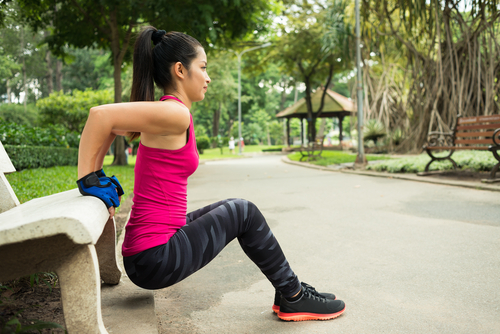Are Dips Bad For You?
Also Known As: tricep dips
Short answer
Dips are very good for you, so long as you do them correctly. As with any exercise, improper form can have very negative consequences.
Very healthy and numerous health benefits. A few harmful qualities may be associated, but only under certain circumstances such as an allergic reaction.
View Full Grading System
Category 'A'
Very healthy and numerous health benefits. Side effects are rare. Things rated an 'A+' are typically necessary for survival (for example, water).
Very healthy and numerous health benefits. A few harmful qualities may be associated, but only under certain circumstances such as an allergic reaction.
Very healthy and numerous health benefits. Harmful qualities may be associated, but aren't usually serious.
It is important to note that even the best things in life can become bad in immoderate amounts. So, although something may be rated an 'A+', overconsumption/overdoing can bring unwanted effects.
Category 'B'
Very beneficial to your health. Things rated a 'B+' may have a few harmful qualities to pay attention to.
Overall beneficial to your health. Things rated a 'B' may have some harmful qualities to pay attention to.
More beneficial to your health than not. However, harmful qualities are most likely associated and shouldn't be overlooked.
The main difference between category 'A' and category 'B' is the harmful qualities typically present in 'B' items. Serious side effects are usually uncommon, but are still possible and should be taken note of.
Category 'C'
Both beneficial and harmful qualities associated. Things rated a 'C+' are typically a bit more on the beneficial side. Still, moderation is important.
A fairly even ratio of beneficial and harmful qualities. Moderation is important. Very general topics that can lean towards both sides of the spectrum will be placed here as well. Rice, for example, can be good or bad depending on the type.
More harmful than beneficial. Side effects are common, especially when consumed/done excessively. Moderation is very important.
Category 'C' usually denotes to both good and bad qualities. When it comes to this category, it is important to keep this word in mind: moderation.
Category 'D'
Harmful to your health. Although benefits may be associated, the bad most likely outweighs the good. Moderation is very important.
Harmful to your health. A few benefits may be associated, but the bad outweighs the good. Moderation is extremely important.
Harmful to your health. Very few, if any, benefits are present. Things in this category should be avoided as much as possible.
Category 'D' is typically for things that are more harmful than beneficial. While consuming/doing something unhealthy once in a blue moon shouldn't hurt, we definitely recommend eliminating 'D' items as a regular part of your routine/diet.
Category 'F'
Category 'F' is for things that fail to bring anything beneficial to the table, and are very harmful to your health. We recommend completely avoiding anything in this category. Long-term side effects of 'F' items are usually very serious.
Category 'N'
'N' stands for neutral. Things placed into this category are generally (a) neither good nor bad for you, or (b) lack the necessary evidence to reach any conclusions.
Long answer
Dips are a very good exercise that continue an old story: humans versus gravity. The purpose of doing dips is to build upper body strength, especially in the triceps brachii. Other muscles worked during dips are the anterior deltoids, rhomboids, latissimus dorsi, and levator scapulae. Which muscles are worked more depends on the angle at which the bars are set. Bars that are closer together will work the triceps more while a wider grip will work the chest muscles more.
Dips all work by the same basic premise - you use your upper body strength to counteract the effect of gravity pulling on your body. As with any exercise, doing dips with improper form can lead to muscle aggravation and even serious injury. The proper way to perform a dip is to grab each bar with the palms facing inwards. With the heels of the palms on top of the bar, push yourself up until your elbows are about to lock (try to keep them from actually locking), keeping your arms slightly angled out. Slowly bring yourself down in a controlled manner until your elbows form a right angle then extend your elbows again to lift yourself back up. If necessary, bend your knees to keep your feet off of the ground. Additionally, the exercise provides the most benefit if you lean forward a bit.
Doing dips slowly and in a controlled manner is very important in preventing injury. Any pain in the shoulders means there is something wrong and you should stop immediately. Even if you feel just a little stretching in your muscles, it means you have reached your limit and should not go for a deeper stretch.
Doing dips incorrectly can lead to serious shoulder or elbow injury. If you cannot perform the exercise (i.e. cannot lift your own body weight or have a previous shoulder/elbow injury), you should avoid dips. One other good thing, though, is that dips are highly modifiable and can be done in such a way that you do not lift your full bodyweight - this is especially true with machine dips. All around, dips are a great exercise for building upper body strength and muscle definition.
Possible short-term side effects
- possible shoulder injury
-
possible elbow injury
Benefits
- works several upper body muscles
-
encourages weight loss
Please turn your Ad Blocker off to see this content. Thank you!
Thank you for your feedback!
Written by Jeff Volling
Published on: 01-09-2016
Last updated: 12-10-2016
Thank you for your feedback!
Written by Jeff Volling
Published on: 01-09-2016
Last updated: 12-10-2016


 Approved by
Approved by 














